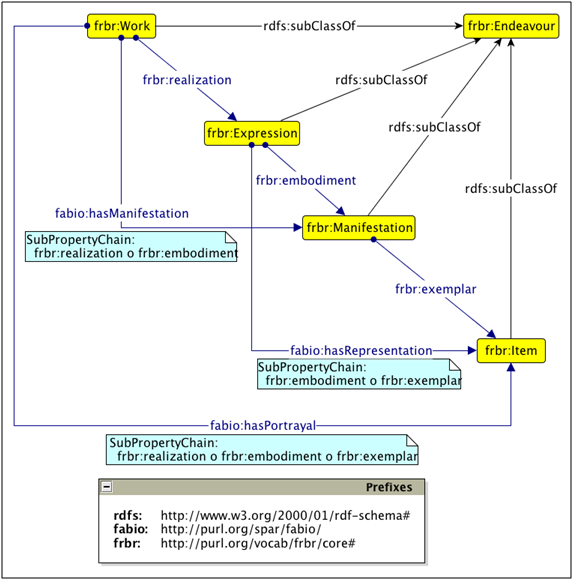FRBR, the Functional Requirements for Bibliographic Records [1] is a general model, proposed by the International Federation of Library Association (IFLA), for describing bibliographic documents. It works for both physical and digital resources and has proved to be very flexible and powerful. One of the most important aspect of FRBR is the fact that it is not associated with a particular metadata schema or implementation. Its defining characteristic is that FRBR describes all documents from four different and correlated points of view, those of Work, Expression, Manifestation and Item, each of which is a FRBR Endeavour.
A Work is a distinct intellectual or artistic creation, an abstract concept recognised through its various expressions. An example of a Work is your latest research paper.
An Expression is the specific form that a Work takes each time it is ‘realized’ in physical or electronic form. For your latest research paper, Draft 5, the preprint, and the published version to which the publisher assigned a unique DOI (Digital Object Identifier), are all Expressions of the same work.
A Manifestation of an expression of a scholarly work defines its particular physical or electronic embodiment. If your latest research paper appeared as an article in a print journal, in the on-line version of that journal as an HTML page, and also as a downloadable PDF file, these are three separate manifestations of the same ‘version of record’ Expression of your work, all bearing the same DOI.
In FRBR, an Item is one single exemplar copy of a Manifestation, i.e. a physical or electronic object that can be owned by a person, for example a particular HTML file on a web server, a printed copy of a journal article on your desk, or a PDF file of that article that you purchased from a publisher and that now resides in digital form on your computer hard drive.
There now exists two different implementations of the core concepts of FRBR using standards that permit the encoding of proper semantics: the first, authored in 2005 by Richard Newman and Ian Davis, is FRBR Core in RDFS, while the second, developed from the first in 2010 by Paolo Ciccarese and Silvio Peroni, is FRBR Core in OWL 2 DL.
FaBiO, the FRBR-aligned Bibliographic Ontology, previously described in this blog post, is an ontology for recording and publishing on the Semantic Web bibliographic records of scholarly endeavours that is structured according to the FRBR model of Works, Expressions, Manifestations and Items.
One of the explicit requests from publishers and end-users of FaBiO was to create shortcuts between particular combinations of FRBR endeavours C:\Documents and Settings\David Shotton\My Documents\Papers and books\Peroni paper CiTO and FaBiO\citofabio_01.odt\iml: – IFLAStudyGroupFRBR(between Work and Manifestation, between Work and Item, and between Expression and Item), since these were not part of the original FRBR model.
Let us introduce a bibliographic reference to illustrate this need:
Yves Marcoux, Élias Rizkallah (2009). Intertextual semantics: A semantics for information design. http://onlinelibrary.wiley.com/doi/10.1002/asi.21134/full.
In this reference, we have a FRBR work – the paper by Marcoux and Rizkallah – and the URL for a specific FRBR item that portrays that work, an HTML file containing the paper on the publisher’s web site. If we wished to link these concepts simply using the FRBR OWL ontology terms, we would be obliged to specify each intermediate FRBR endeavour, namely the expression and manifestation of that paper, even if we were not interested in doing that:
@prefix wiley: <http://onlinelibrary.wiley.com/doi/> .
:intertextual-semantics a frbr:Work
; frbr:creator :marcoux , :rizkallah
; dcterms:title “Intertextual semantics: A semantics for information design”
; frbr:realization [ a frbr:Expression
; frbr:embodiment [ a frbr:Manifestation
; frbr:exemplar wiley:10.1002/asi.21134/full ] ] .
In order to avoid this kind of verbosity, we have supplemented the existing FRBR object properties with three new FaBiO properties shown in the following figure: fabio:hasManifestation that links a Work directly to its Manifestations, fabio:hasPortrayal that links a Work directly to its Items), and fabio:hasRepresentation that links an Expression directly to its Items.

A Graffoo diagram showing the FRBR Core data model, supplemented with three new FaBiO properties.
Note: In Manchester Syntax, the “o” in each sub-property chain is the syntax mechanism for chaining properties.
These added properties allow us to treat the previous example in a less verbose way:
@prefix wiley: <http://onlinelibrary.wiley.com/doi/> .
:intertextual-semantics a frbr:Work
; frbr:creator :marcoux , :rizkallah
; dcterms:title “Intertextual semantics: A semantics for information design”
; fabio:hasPortrayal wiley:10.1002/asi.21134/full .
[1] IFLA Study Group on the Functional Requirements for Bibliographic Records (2009). Functional Requirements for Bibliographic Records Final Report. International Federation of Library Associations and Institutions. http://www.ifla.org/en/publications/functional-requirements-for-bibliographic-records.

Pingback: Comparison of BIBO and FaBiO | JISC Open Citations
Pingback: JISC Open Citations Project – Final Project Blog Post | JISC Open Citations
Pingback: Comparison of BIBO and FaBiO | Semantic Publishing